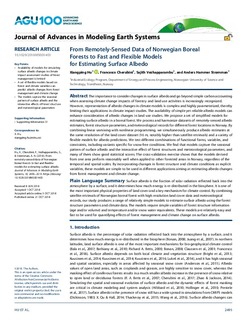| dc.contributor.author | Hu, Xiangping | |
| dc.contributor.author | Cherubini, Francesco | |
| dc.contributor.author | Vezhapparambu, Sajith | |
| dc.contributor.author | Strømman, Anders Hammer | |
| dc.date.accessioned | 2019-02-22T09:26:45Z | |
| dc.date.available | 2019-02-22T09:26:45Z | |
| dc.date.created | 2018-10-06T17:07:32Z | |
| dc.date.issued | 2018 | |
| dc.identifier.citation | Journal of Advances in Modeling Earth Systems. 2018, 10 (10), 2495-2513. | nb_NO |
| dc.identifier.issn | 1942-2466 | |
| dc.identifier.uri | http://hdl.handle.net/11250/2586943 | |
| dc.description.abstract | The importance to consider changes in surface albedo and go beyond simple carbon accounting when assessing climate change impacts of forestry and land use activities is increasingly recognized. However, representation of albedo changes in climate models is complex and highly parameterized, thereby limiting their applications in climate impact studies. The availability of simple yet reliable albedo models can enhance consideration of albedo changes in land use studies. We propose a set of simplified models for estimating surface albedo in a boreal forest. We process and harmonize datasets of remotely‐sensed albedo estimates, forest structure parameters, and meteorological records for different forest locations in Norway. By combining linear unmixing with nonlinear programming, we simultaneously produce albedo estimates at the same resolution of the land cover dataset (16 m, notably higher than satellite retrievals) and a variety of flexible models for albedo predictions. We test different combinations of functional forms, variables, and constraints, including variants specific for snow‐free conditions. We find that models capture the seasonal pattern of surface albedo and the interactive effect of forest structures and meteorological parameters, and many of them show good statistical scores. The cross‐validation exercise shows that the models derived from one area perform reasonably well when applied to other forested areas in Norway, regardless of the temporal and spatial scales. By incorporating changes in forest structure and climate conditions as explicit variables, these models are simple to be used in different applications aiming at estimating albedo changes from forest management and climate change. | nb_NO |
| dc.language.iso | eng | nb_NO |
| dc.publisher | American Geophysical Union (AGU) | nb_NO |
| dc.rights | Attribution-NonCommercial-NoDerivatives 4.0 Internasjonal | * |
| dc.rights.uri | http://creativecommons.org/licenses/by-nc-nd/4.0/deed.no | * |
| dc.title | From remotely‐sensed data of Norwegian boreal forests to fast and flexible models for estimating surface albedo | nb_NO |
| dc.type | Journal article | nb_NO |
| dc.type | Peer reviewed | nb_NO |
| dc.description.version | publishedVersion | nb_NO |
| dc.source.pagenumber | 2495-2513 | nb_NO |
| dc.source.volume | 10 | nb_NO |
| dc.source.journal | Journal of Advances in Modeling Earth Systems | nb_NO |
| dc.source.issue | 10 | nb_NO |
| dc.identifier.doi | 10.1029/2018MS001403 | |
| dc.identifier.cristin | 1618424 | |
| dc.relation.project | Norges forskningsråd: 209697 | nb_NO |
| dc.relation.project | Norges forskningsråd: 244074 | nb_NO |
| dc.description.localcode | © 2018. The Authors. This is an open access article under the terms of the Creative Commons Attribution‐NonCommercial‐NoDerivs License. | nb_NO |
| cristin.unitcode | 194,64,25,0 | |
| cristin.unitname | Institutt for energi- og prosessteknikk | |
| cristin.ispublished | true | |
| cristin.fulltext | original | |
| cristin.qualitycode | 1 | |

